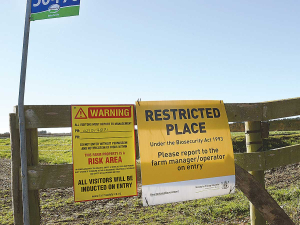How to make raw milk reliable for calves
Feeding infected milk is high risk for spreading diseases such as M. bovis.
 A provincial declaration that New Zealand is free from Mycoplasma bovis could be made in October or November.
A provincial declaration that New Zealand is free from Mycoplasma bovis could be made in October or November.
A major milestone on New Zealand's unique journey to eradicate Mycoplasma bovis could come before the end of this year.
A provincial declaration that the country is free of Mycoplasma bovis may be made in either October or November, says Ministry for Primary Industries (MPI) director-general Ray Smith.
Speaking at the Primary Industries NZ Summit in Christchurch last week, he says the eradication of M. bovis has been "a real success story".
"So, if you were involved in that in any way, you have our deepest understanding of how difficult it is to have someone turn up on your farm one day and say, 'actually putting a notice on it, you're going to stop what you're doing until we clean this up'," says Smith.
"About 300 farmers had that experience. But we haven't had this disease turn up for two years now."
Smith says NZ has achieved something the rest of the world said couldn't be done.
"We spent $750 million getting to this point, industry and government both contributing to solving that problem. We're almost there.
"We'll see, if we get through this spring, which is the risky period, by October, November, we'll declare provisional freedom of absence of Mycoplasma bolus in New Zealand. And that's a great thing. To not have to live with lameness, aborted calves and mastitis related problems in our animals is a good thing to have achieved."
The M. bovis programme, jointly funded by the Government and farmers, started in 2018 and should finish by 2018.
Under the programme, we need to pass through three phases to provide confidence that M. bovis is absent in cattle herd - delimiting phase to identify and remove cases of infection and provisional absence - focussing on monitoring the cattle population through background surveillance. There needs to be two consecutive clear springs and two consecutive clear autumn calving periods to build up a good level of confidence that M. bovis is no longer present.
The third phase is confidence of absence. In this phase, background surveillance continues until the industry achieves a very high level of confidence that M. bovis is eradicated. This phase is expected to run for two years. The confidence of absence phase ends with a statement of absence and M. bovis is then considered exotic.
The dairy sector is in a relatively stable position, with strong milk price payout forecasts continuing to offset ongoing high farm costs, according to DairyNZ.
A shameless political stunt is how Federated Farmers is describing the Canterbury Regional Council decision to declare “a nitrate emergency” on the back of its latest annual groundwater quality survey.
Fonterra has delivered a fifth straight year of record organic milk price for farmer suppliers.
Fonterra says favourable weather conditions supporting pasture growth is boosting milk production.
Science is pivotal to driving progress and unlocking opportunity and innovation in the ag sector, says DairyNZ chief executive and chair of the Agribusiness in Schools programme, Campbell Parker.
DairyNZ chair Tracy Brown says history shows that when New Zealand needs an economic lift, dairy delivers.